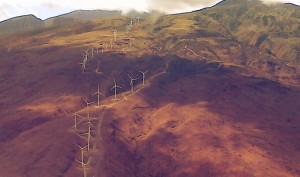Hawaiian Electric Submits Interim Status Report

Maui’s first windfarm project, the Kaheawa Windfarm, is located in Maalaea. The Ulupalakua project is designed to capture wind resources on the other side of Maui’s isthmus along the Slopes of Haleakala. Other wind projects that have been discussed for Lāna’i have been met with controversy over potential transport of wind energy off-island. Aerial photography by Wendy Osher.
The Hawaiian Electric Companies on Tuesday submitted an interim status report on plans for a diverse mix of energy resources to meet the state’s 100 percent Renewable Portfolio Standard by 2045.
The interim report was requested by the Hawai’i Public Utilities Commission.
A recommended preferred plan and a proposed five-year action plan for each of the five islands served by the Hawaiian Electric Companies will be included when the updated Power Supply Improvement plans are filed in April.
“This status report is a work in progress, and reflects our commitment to achieve our state’s 100 percent renewable portfolio standard,” said Alan Oshima, Hawaiian Electric president and CEO. “As we plan for how to get there, we’re focused on protecting our environment, and ensuring the reliable service and reasonable costs our customers expect and deserve.
“With a 30-year planning horizon, any plan developed today will naturally evolve and the flexibility to incorporate changing technology and other developments is critical,” said Oshima in a company announcement.
Below are some highlights of the interim report as outlined by Hawaiian Electric Company:
A diverse energy mix
Preliminary work suggests that Hawai‘i could be powered by 100 percent renewable generation for electricity by 2045, phasing out oil and coal along the way and adding to a diverse renewable energy mix that could include more energy from:
- Distributed resources like rooftop photovoltaic systems
- Utility-scale renewable generation including solar and wind, some of it potentially located off-shore
- Geothermal
- Biomass
- Biofuels
As variable sources of renewable power like solar and wind increase, other resources and energy technologies will be needed to provide backup and ensure reliable service for all customers. These will include:
- Microgrids
- Demand response options that allow customers to play a role in the operation of the electric grid by reducing or shifting their electricity use in response to grid conditions
- Energy storage, both customer-owned and utility-scale projects
Along with these resources, modern fast starting, quick ramping generators are needed to balance the variability of solar and wind power. Using liquefied natural gas could provide a transitional fuel that minimizes price volatility and is much cleaner and lower in cost for customers than oil until LNG is phased out in favor of renewable options.
Preliminary analysis indicates the approach with the lowest overall cost and most significant reduction in emissions includes replacing three older oil-fired steam generator units at the Kahe Generating Station with a new, fuel-saving combined-cycle system running on LNG for the transition period to 100 percent renewable energy. When measured against current carbon dioxide emission levels, it is estimated this concept, along with other system improvements, could reduce these emissions by more than four million tons when this option could be fully operational. This is the equivalent of removing 133,000 passenger vehicles from the road each year.
This option was identified in collaboration with NextEra Energy, as it would require the financial backing and development capacity of a merged utility. The proposed merger between Hawaiian Electric Industries and NextEra Energy requires the approval of the PUC and review of the transaction is in process.
Collaboration with stakeholders
Collaboration with stakeholders is critical to this process. The PUC has named 23 parties in this docket. These parties have provided input, which informed and influenced the analysis thus far. In addition to receiving written feedback from the parties, the Hawaiian Electric Companies held a stakeholder conference on Dec. 17, 2015, followed by a PUC technical conference on Jan. 7, 2016. Two additional technical conferences have been proposed.
Additional independent technical analysis is being provided by the US Department of Energy, National Renewable Energy Laboratory, Hawaii Energy, Natural Energy Institute, Electric Power Research Institute, and General Electric.










